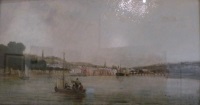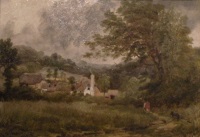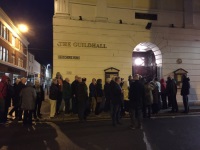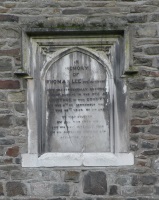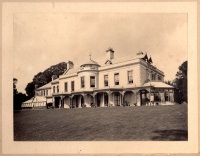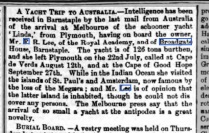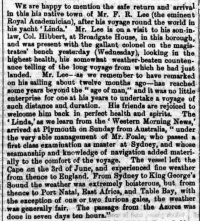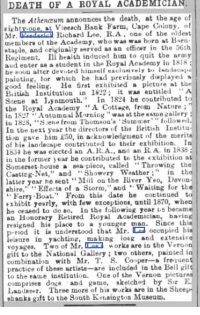| Home |
Save
Manning's Pit Petition - closed |
About the
Exhibition |
Benjamin Manning |
Colonel and Sarah Hibbert |
Saki |
Henry Williamson |
Timeline |
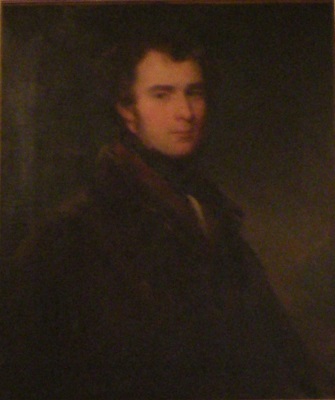 Frederick Richard Lee, R. A.Eminent Victorian Artist who lived close to Manning's Pit
|
|
The Lane to Pitt Farm, Raleigh, Pilton,
by F R Lee, 1830 |
The
portrait, above, of F R Lee as a youngish man is
in the Museum of Barnstaple and North Devon and was
displayed in our Exhibition there in May 2017. The
Museum has several paintings by Lee, including a large
one that can be seen in the foyer, and a charming
smaller painting of Barnstaple Bridge (left) that was
shown in our Exhibition (apologies for dazzle on
photograph, it was taken during the Exhibition) We were also able to display - thanks to the Athenaeum at Barnstaple Library - this painting, also on the left. (again the photograph is not best quality as taken while exhibition was on.) It was discovered in recent years, and has been restored. Pitt Farm and Raleigh are on the opposite side of Pilton to Manning's Pit, and this painting was done before F R Lee moved to Pilton. Interestingly, when Benjamin Manning came to Devon from Tiverton, he first worked at a lace factory in the Raleigh area of Pilton. |
|
F R Lee was a
prodigious artist and it is believed that there are
many more of his paintings in existence still, that
have not been rediscovered. While he lived at
Broadgate House. it seems more likely than not that he
must have gone out into Manning's Pit at times to
sketch or paint, just as so many artists living in
this area do so today. The field had not yet attained
its name, so the painting might be difficult to
identify, especially as trees grow, fall and are
replaced. But we are still looking! We
have also made contact with the Melbourne Public
Library in Australia recently, and we are hoping to
find out more about any paintings by Lee that can be
found there - to read more about Lee's trip to
Australia, scroll down.
A link to 58 of F R Lee's paintings in various locations: One or two paintings look as if they could be possibles, especially Cover Side. Here is a link to an exciting new biography of F R Lee by Kenneth J. Westwood: Frederick Richard Lee R.A. 1798- 1879 Painter Sportsman Photographer YachtsmanFrom this book, we
learned that at one time critics considered Lee a
better artist than Constable, who was apparently
jealous of Lee's fame. While Lee's reputation has
suffered since then, the time may come when it will be
re-appraised. |
|
People filing into the Guildhall in
2017,
at the Town Council Planning Meeting about Manning's Pit |
F.R.
Lee was born in Barbican House, near Trinity Church,
Barnstaple, in 1798. F R Lee's father was a successful architect, as was his older brother, Thomas, who designed Arlington House and the Barnstaple Guildhall (see left) among other buildings. |
F R Lee and J M W
Turner
In 1818 Lee became a student at the Royal Academy where he may have met J.M.W. Turner, whose family came from North Devon and whose uncle lived in Barnstaple (first in central Barnstaple but later in Littabourne, Pilton.) From Kenneth Westwood's book, we have also learned that both Lee and Turner attended various important house parties put on by patrons of the Arts. The fact that they both had close connections with Banrstaple, and Pilton, raised our interest. We are still researching possible collaborations, and have already found one, which is mentioned further down the page. Lee was elected to the Royal Academy in 1838 and became a very successful and famous Victorian landscape artist. He did not like painting animals and because of this two other famous artists, Sir Edwin Landseer and Thomas Sidney Cooper often collaborated with him. |
|
Thanks to the Henry Williamson
Society for this image |
Lee
lived with his first wife Harriet in both Devon and
Kent, and they had three children, including the
youngest daughter Sarah Catherine, but after Harriet's
death and his later remarriage, Lee moved back to Devon
in 1858. Broadgate House in Pilton was owned by his
second wife Mary. It is only about a quarter of a mile
from Manning's Pit. Mary died suddenly within eighteen
months of their marriage, and Broadgate House was left
to Lee. It became the family home. His daughter
Sarah was to live there with her husband Col Hugh
Hibbert for many years. Lee's other passion in life was sailing, and he traveled extensively in his yachts, to places like Spain. The thumbnail on the left gives you a link to a charming painting in the Royal Academy of a sunfish that he caught while sailing from Algeria to Gibraltar in 1857, not long before he moved back to Devon. His granddaughter married the brother of Sir Francis Chichester's father, who sailed single handed round the world in the 1960, nearly a hundred years after Lee's journey to Australia (in a far more luxurious yacht.) |
|
Here is a link to
three paintings by, or after, F R Lee in the National
Gallery of Victoria
More will be added here, about Lee's Australian visit. The Melbourne Public Library gave us the above link. |
|
More
about Lee and J.M.W. Turner R.A.
While researching newspaper reports in the British Newspaper Archive we also discovered that at the sale of the Broadgate Estate in 1918 a painting titled “Burning Mill at Yeoford” was sold. It was described as being by F R Lee, R A, and also “touched in” by J M W Turner. R A. This demonstrates collaboration between the two artists. The report was in the Exeter and Plymouth Gazette of 16 May 1918, and there is a link to a newspaper cutting of this report on the Sarah Hibbert Page. |
 |
Sarah
Hibbert, F R Lee's daughter, was also an important
figure in the life of Pilton for man years. Her husband
Colonel Hugh Hibbert, fought in the Crimean war, became
a war hero, and was later to become very involved in
Pilton and Barnstaple life. He was Mayor of Barnstaple
in 1893 and the couple entertained Royalty at Broadgate
House in 1895. After the Colonel's death, life was
to become more difficult for Sarah, who was faced with
saddling the debts of a wayward son. She eventually had
to sell the Estate to settle these debts. Link to page about Sarah and Hugh Hibbert The couple's granddaughter, Ida Loetitia Hibbert, married Henry Williamson (she is featured as a character in the book of Tarka The Otter). Williamson was very fond of Sarah (known as Grannie Hibbert) and dedicated his book, The Village Book, to her. |
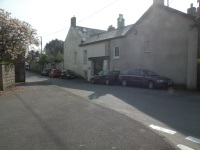 |
This photograph shows the back of Broadgate
House, as it is today. It was taken from the pavement
outside the house where the Munros (and the young Saki)
lived. They were very close neighbours, and we have been
told that the Hibberts and the Munros almost certainly
did indeed socialise, despite the fact that it is often
said that the Munro children rarely saw any
neighbours. The Hibberts had young children around
the ages of the Munro children, and they would have seen
each other every Sunday at Church, as well as walking to
and from the Church the same way. |
|
Still
to come on this page:
More articles about Frederick Lee's travels to Australia, and details about his career as an artist, plus information about the six - or possibly seven - mills of the Bradiford Valley. F R Lee was very fond of painting mills, and when he wanted to sketch one locally, his route would have taken him through Manning's Pit. We are also interested in the fact that it seems exceedingly likely that the young Hector Munro (Saki) visited Broadgate House, and was exposed to Lee's paintings as well as other workd of Art in the house. The subject of Art, and paintings, occurs in several of his stories, most notably The East Wing... how easy it is, reading this, to imagine it was set in Broadgate House! Some of the information here comes from Margaret Reed, who is so knowledgeable about Pilton's History, and you can read her page on the Pilton Story Website which gives more details and the full story of Lee's life, at the link below Frederick Richard Lee - his life, by Margaret Reed. |
